Network distance tying it all together¶
Here, we will calculate the walking distance for students in public schools to their nearest subway entrance.
[37]:
import geopandas as gpd
import pandas as pd
import matplotlib.pyplot as plt
import networkx as nx
from shapely.geometry import box, LineString, Point,MultiPoint
import os
import sys
from scipy.spatial import cKDTree
import numpy as np
from zipfile import ZipFile as zzip
import requests
from rtree import index
import rtree
import itertools
from shapely import wkt
from shapely.ops import split, snap
import time
sys.path.append(os.path.realpath('..'))
[6]:
os.getcwd()
[6]:
'C:\\Work\\Box Sync\\GIS_exploration\\code'
Get the 2019 “NYC LION Single Line Street Base Map”¶
[29]:
url = r"https://www1.nyc.gov/assets/planning/download/zip/data-maps/open-data/nyclion_19b.zip"
filename = r"nyclion_19b.zip"
r = requests.get(url)
# open method to open a file on your system and write the contents
with open("../input_data/"+filename, "wb") as file:
file.write(r.content)
[30]:
fp = "../input_data/"
foldername = "nyclion_19b"
with zzip(fp+filename, 'r') as file:
#printing all the contents of the zip file
#file.printdir()
path = "../input_data/"+foldername
os.mkdir(path)
# extracting all the files
print('Extracting all the files now...')
file.extractall(fp+foldername)
print('Done!')
File Name Modified Size
lion/lion.gdb/a00000001.freelist 2019-05-13 12:48:56 4440
lion/lion.gdb/a00000001.gdbindexes 2019-05-13 12:42:56 110
lion/lion.gdb/a00000001.gdbtable 2019-05-13 12:48:56 385
lion/lion.gdb/a00000001.gdbtablx 2019-05-13 12:48:56 5152
lion/lion.gdb/a00000001.TablesByName.atx 2019-05-13 12:48:56 4118
lion/lion.gdb/a00000002.gdbtable 2019-05-13 12:42:56 2055
lion/lion.gdb/a00000002.gdbtablx 2019-05-13 12:42:56 5152
lion/lion.gdb/a00000003.gdbindexes 2019-05-13 12:42:56 42
lion/lion.gdb/a00000003.gdbtable 2019-05-13 12:44:22 1825
lion/lion.gdb/a00000003.gdbtablx 2019-05-13 12:44:22 5152
lion/lion.gdb/a00000004.CatItemsByPhysicalName.atx 2019-05-13 12:48:56 4118
lion/lion.gdb/a00000004.CatItemsByType.atx 2019-05-13 12:48:56 4118
lion/lion.gdb/a00000004.FDO_UUID.atx 2019-05-13 12:48:56 4118
lion/lion.gdb/a00000004.freelist 2019-05-13 12:49:38 57688
lion/lion.gdb/a00000004.gdbindexes 2019-05-13 12:42:56 310
lion/lion.gdb/a00000004.gdbtable 2019-05-13 12:49:38 399741
lion/lion.gdb/a00000004.gdbtablx 2019-05-13 12:49:38 5152
lion/lion.gdb/a00000004.spx 2019-05-13 12:49:30 45078
lion/lion.gdb/a00000005.CatItemTypesByName.atx 2019-05-13 12:42:56 12310
lion/lion.gdb/a00000005.CatItemTypesByParentTypeID.atx 2019-05-13 12:42:56 4118
lion/lion.gdb/a00000005.CatItemTypesByUUID.atx 2019-05-13 12:42:56 4118
lion/lion.gdb/a00000005.gdbindexes 2019-05-13 12:42:56 296
lion/lion.gdb/a00000005.gdbtable 2019-05-13 12:42:56 1803
lion/lion.gdb/a00000005.gdbtablx 2019-05-13 12:42:56 5152
lion/lion.gdb/a00000006.CatRelsByDestinationID.atx 2019-05-13 12:48:56 4118
lion/lion.gdb/a00000006.CatRelsByOriginID.atx 2019-05-13 12:48:56 4118
lion/lion.gdb/a00000006.CatRelsByType.atx 2019-05-13 12:48:56 4118
lion/lion.gdb/a00000006.FDO_UUID.atx 2019-05-13 12:48:56 4118
lion/lion.gdb/a00000006.freelist 2019-05-13 12:48:56 4440
lion/lion.gdb/a00000006.gdbindexes 2019-05-13 12:42:56 318
lion/lion.gdb/a00000006.gdbtable 2019-05-13 12:48:56 701
lion/lion.gdb/a00000006.gdbtablx 2019-05-13 12:48:56 5152
lion/lion.gdb/a00000007.CatRelTypesByBackwardLabel.atx 2019-05-13 12:42:56 4118
lion/lion.gdb/a00000007.CatRelTypesByDestItemTypeID.atx 2019-05-13 12:42:56 4118
lion/lion.gdb/a00000007.CatRelTypesByForwardLabel.atx 2019-05-13 12:42:56 4118
lion/lion.gdb/a00000007.CatRelTypesByName.atx 2019-05-13 12:42:56 4118
lion/lion.gdb/a00000007.CatRelTypesByOriginItemTypeID.atx 2019-05-13 12:42:56 4118
lion/lion.gdb/a00000007.CatRelTypesByUUID.atx 2019-05-13 12:42:56 4118
lion/lion.gdb/a00000007.gdbindexes 2019-05-13 12:42:56 602
lion/lion.gdb/a00000007.gdbtable 2019-05-13 12:42:56 2504
lion/lion.gdb/a00000007.gdbtablx 2019-05-13 12:42:56 5152
lion/lion.gdb/a0000000a.gdbindexes 2019-05-13 12:44:48 116
lion/lion.gdb/a0000000a.gdbtable 2019-05-13 12:44:48 3247250
lion/lion.gdb/a0000000a.gdbtablx 2019-05-13 12:44:48 665632
lion/lion.gdb/a0000000a.spx 2019-05-13 12:44:48 1609750
lion/lion.gdb/a0000000b.gdbindexes 2019-05-13 12:44:56 66
lion/lion.gdb/a0000000b.gdbtable 2019-05-13 12:45:24 5491953
lion/lion.gdb/a0000000b.gdbtablx 2019-05-13 12:45:24 1172512
lion/lion.gdb/a0000000c.gdbindexes 2019-05-13 12:45:30 66
lion/lion.gdb/a0000000c.gdbtable 2019-05-13 12:45:42 6406110
lion/lion.gdb/a0000000c.gdbtablx 2019-05-13 12:45:42 527392
lion/lion.gdb/a0000000d.freelist 2019-05-13 12:48:44 20824
lion/lion.gdb/a0000000d.gdbindexes 2019-05-13 12:48:30 116
lion/lion.gdb/a0000000d.gdbtable 2019-05-13 12:48:44 126137796
lion/lion.gdb/a0000000d.gdbtablx 2019-05-13 12:48:44 1136672
lion/lion.gdb/a0000000d.spx 2019-05-13 12:48:30 4362262
lion/lion.gdb/gdb 2019-05-13 12:42:56 4
lion/lion.gdb/timestamps 2019-05-13 12:47:14 400
lion/LION - Street Name Labels.lyr 2013-09-24 18:10:22 18432
lion/LION Streets - Generic.lyr 2017-02-10 07:51:36 21504
lion/LION Streets - Roadbeds.lyr 2017-02-10 07:54:38 21504
lion/LION - Generic.lyr 2017-02-10 07:48:08 24576
lion/LION - Roadbeds.lyr 2017-02-10 07:49:32 24576
lion/LION - Nodes.lyr 2012-08-17 13:19:50 11776
lion/LION - Street Direction Arrows (ArcGIS 10x).lyr 2013-01-15 10:58:06 22528
lion/LION - Street Direction Arrows (Requires Maplex).lyr 2013-03-12 14:22:44 22528
lion/TrafficRepArrows.style 2012-09-27 08:32:40 598016
lion/ReadMe.txt 2014-03-17 15:27:04 7758
altnames_metadata.html 2019-05-13 12:49:22 38976
altnames_metadata.pdf 2019-05-13 14:35:58 129541
lion_metadata.html 2019-05-13 12:49:12 199830
lion_metadata.pdf 2019-05-13 14:35:22 483768
node_metadata.html 2019-05-13 12:49:32 42396
node_metadata.pdf 2019-05-13 14:34:28 135027
node_stname_metadata.html 2019-05-13 12:49:40 32999
node_stname_metadata.pdf 2019-05-13 14:36:56 123835
Extracting all the files now...
Done!
Reading the lion layer into a geopandas dataframe
[31]:
fp = "../input_data/nyclion_19b/lion/lion.gdb"
lion_gdf = gpd.read_file(fp, driver='FileGDB', layer='lion')
Removing the non pedestrian accessible roads/paths
[32]:
lion_gdf['todrop'] = (lion_gdf['NonPed'] == 'V') |(lion_gdf['FeatureTyp'].isin(['F','9','1','7','3'])) |(lion_gdf['TrafDir'].isin([' ']))
[33]:
lion_gdf = lion_gdf.loc[lion_gdf['todrop'] == False]
[34]:
lion_gdf.crs
[34]:
{'init': 'epsg:2263'}
[41]:
lion_gdf.plot(figsize = (10,10), markersize = 1);
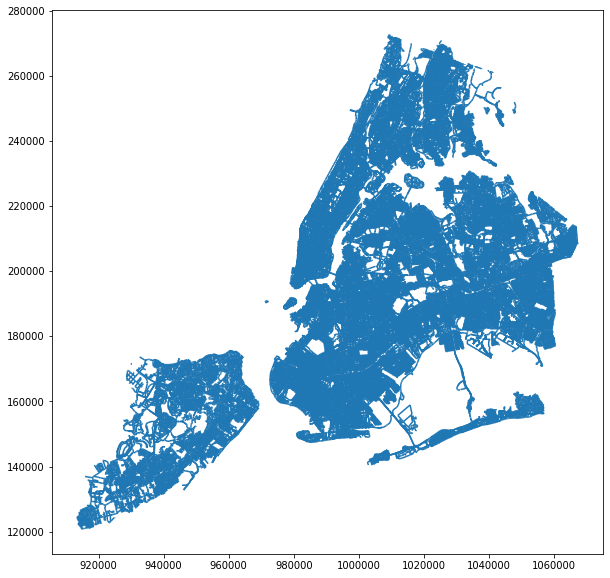
[46]:
lion_gdf.head()
[46]:
| Street | SAFStreetName | FeatureTyp | SegmentTyp | IncExFlag | RB_Layer | NonPed | TrafDir | TrafSrc | SpecAddr | ... | RLo_Hyphen | RHi_Hyphen | FromLeft | ToLeft | FromRight | ToRight | Join_ID | SHAPE_Length | geometry | todrop | |
|---|---|---|---|---|---|---|---|---|---|---|---|---|---|---|---|---|---|---|---|---|---|
| 0 | EAST 168 STREET | 0 | U | B | T | DOT | ... | 596 | 716 | 599 | 699 | 596 | 716 | 2251001000000 | 396.030947 | (LINESTRING (1010964.446978778 241812.26140345... | False | ||||
| 1 | WEST 192 STREET | 0 | U | B | A | DOT | ... | 63 | 99 | 58 | 98 | 63 | 99 | 2798401000000 | 279.360514 | (LINESTRING (1011576.686607853 255023.58303095... | False | ||||
| 2 | UNION AVENUE | 0 | U | B | W | DOT | ... | 1016 | 1084 | 1017 | 1079 | 1016 | 1084 | 2728001000000 | 618.327133 | (LINESTRING (1011600.676209003 239639.74280026... | False | ||||
| 3 | UNION AVENUE | BEHAGEN PLAYGROUND | 0 | U | B | W | DOT | N | ... | None | None | 0 | 0 | 0 | 0 | 21279501000000N | 618.327133 | (LINESTRING (1011600.676209003 239639.74280026... | False | ||
| 4 | DELAFIELD AVENUE | 6 | U | B | T | DOT | ... | 4600 | 4664 | 4601 | 4645 | 4600 | 4664 | 2187601000000 | 670.281037 | (LINESTRING (1009974.212831751 264857.13919802... | False |
5 rows × 119 columns
[54]:
fp = r"../intermediate_data/nyclion_19b/"
os.mkdir(fp)
lion_gdf[['geometry']].to_file(fp+"nyclion_19b.shp")
Getting the public school location data from NYC Open Data¶
[19]:
url = r"https://data.cityofnewyork.us/download/jfju-ynrr/application%2Fzip"
filename = r"Public_School_Locations.zip"
r = requests.get(url)
# open method to open a file on your system and write the contents
with open("../input_data/"+filename, "wb") as file:
file.write(r.content)
[23]:
fp = "../input_data/"
foldername = "Public_School_Locations"
with zzip(fp+filename, 'r') as file:
# printing all the contents of the zip file
file.printdir()
path = "../input_data/"+foldername
os.mkdir(path)
# extracting all the files
print('Extracting all the files now...')
file.extractall(fp+foldername)
print('Done!')
File Name Modified Size
Public_Schools_Points_2011-2012A.dbf 2011-08-26 10:30:16 771337
Public_Schools_Points_2011-2012A.prj 2010-10-12 11:55:12 562
Public_Schools_Points_2011-2012A.sbn 2011-08-03 11:23:00 16580
Public_Schools_Points_2011-2012A.sbx 2011-08-03 11:23:00 868
Public_Schools_Points_2011-2012A.shp 2011-08-03 11:23:00 47952
Public_Schools_Points_2011-2012A.shp.xml 2011-08-26 10:32:50 28413
Public_Schools_Points_2011-2012A.shx 2011-08-03 11:23:00 13772
Extracting all the files now...
Done!
Read the school point shapefile into a geopandas geodataframe
[2]:
fp = "../input_data/Public_School_Locations/Public_Schools_Points_2011-2012A.shp"
schools = gpd.read_file(fp)
[3]:
schools.crs
[3]:
{'init': 'epsg:2263'}
[42]:
schools.head()
[42]:
| ATS_CODE | BORO | BORONUM | LOC_CODE | SCHOOLNAME | SCH_TYPE | MANAGED_BY | GEO_DISTRI | ADMIN_DIST | ADDRESS | STATE_CODE | ZIP | PRINCIPAL | PRIN_PH | FAX | GRADES | City | geometry | |
|---|---|---|---|---|---|---|---|---|---|---|---|---|---|---|---|---|---|---|
| 0 | 15K001 | K | 2.0 | K001 | P.S. 001 THE BERGEN | Elementary | 1 | 15 | 15 | 309 47 STREET | NY | 11220 | Jennifer Eusanio | 718-567-7661 | 718-567-9771 | PK,0K,01,02,03,04,05,SE | BROOKLYN | POINT (980985.0541713729 175780.758994163) |
| 1 | 17K002 | K | 2.0 | K002 | M.S. 002 | Junior High-Intermediate-Middle | 1 | 17 | 17 | 655 PARKSIDE AVENUE | NY | 11226 | ADRIENNE SPENCER | 718-462-6992 | 718-284-7717 | 06,07,08,SE | BROOKLYN | POINT (997785.1364296663 178431.910832498) |
| 2 | 21K095 | K | 2.0 | K095 | P.S. 095 THE GRAVESEND | K-8 | 1 | 21 | 21 | 345 VAN SICKLEN STREET | NY | 11223 | Janet Ndzibah | 718-449-5050 | 718-449-3047 | PK,0K,01,02,03,04,05,06,07,08,SE | BROOKLYN | POINT (991224.9830063033 156323.3612131244) |
| 3 | 21K096 | K | 2.0 | K096 | I.S. 096 SETH LOW | Junior High-Intermediate-Middle | 1 | 21 | 21 | 99 AVENUE P | NY | 11204 | Denise Sandra Levinsky | 718-236-1344 | 718-236-2397 | 06,07,08,SE | BROOKLYN | POINT (988439.6813609767 160709.9926236183) |
| 4 | 21K097 | K | 2.0 | K097 | P.S. 97 THE HIGHLAWN | Elementary | 1 | 21 | 21 | 1855 STILLWELL AVENUE | NY | 11223 | KRISTINE MUSTILLO | 718-372-7393 | 718-372-3842 | PK,0K,01,02,03,04,05,SE | BROOKLYN | POINT (988205.0729096507 158329.5913366843) |
[115]:
schools['BORONUM'].value_counts()
[115]:
2.0 902
1.0 348
4.0 341
5.0 73
3.0 43
0.0 2
Name: BORONUM, dtype: int64
[170]:
schools.plot(figsize = (10,10), markersize = 1, color = 'blue');
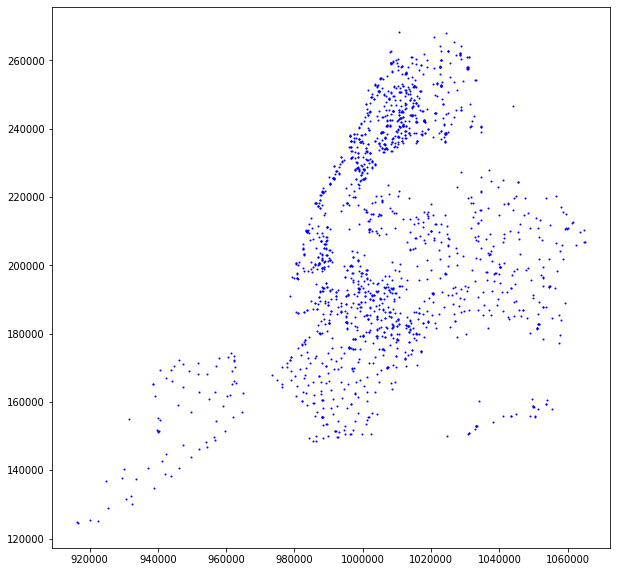
Getting the subway information¶
Read the subway entract shapefile into a geopandas geodataframe
[4]:
fp = r"https://data.cityofnewyork.us/api/geospatial/drex-xx56?method=export&format=Shapefile"
subway = gpd.read_file(fp)
[5]:
subway.crs
[5]:
{'init': 'epsg:4326'}
[6]:
subway = subway.to_crs({'init': 'epsg:2263'})
[7]:
subway.head()
[7]:
| line | name | objectid | url | geometry | |
|---|---|---|---|---|---|
| 0 | 2-5 | Birchall Ave & Sagamore St at NW corner | 1734.0 | http://web.mta.info/nyct/service/ | POINT (1020670.668616476 248679.9905504963) |
| 1 | 2-5 | Birchall Ave & Sagamore St at NE corner | 1735.0 | http://web.mta.info/nyct/service/ | POINT (1020710.253511059 248665.112299423) |
| 2 | 2-5 | Morris Park Ave & 180th St at NW corner | 1736.0 | http://web.mta.info/nyct/service/ | POINT (1019251.986414479 245782.8697043241) |
| 3 | 2-5 | Morris Park Ave & 180th St at NW corner | 1737.0 | http://web.mta.info/nyct/service/ | POINT (1019419.817771734 245866.9102186682) |
| 4 | 2-5 | Boston Rd & 178th St at SW corner | 1738.0 | http://web.mta.info/nyct/service/ | POINT (1017557.721758398 245631.8322767556) |
[8]:
subway = subway.reset_index()
[9]:
subway['index'] = subway.index
[168]:
subway.plot(figsize = (10,10), markersize = 1, color = 'red');
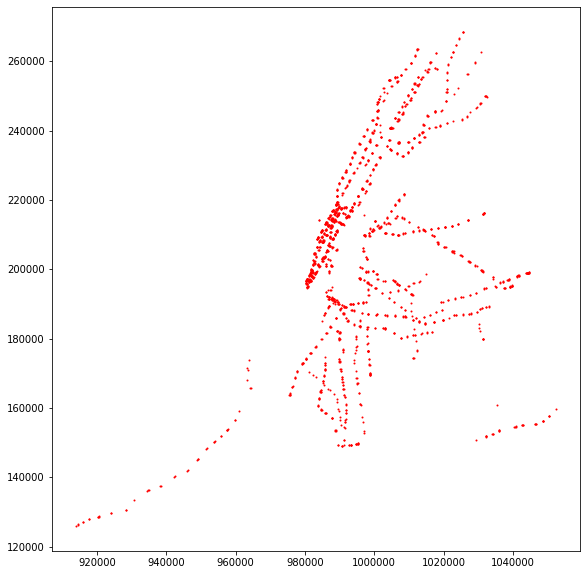
Adding these points into the street network¶
[55]:
fp = r"../intermediate_data/nyclion_19b/"
lion_graph = nx.read_shp(fp+"nyclion_19b.shp", simplify = True, geom_attrs = True, strict = True)
[56]:
fp = r"../intermediate_data/nyclion_19b/"
nx.write_shp(lion_graph, fp)
[57]:
fp = r"../intermediate_data/nyclion_19b/"
# load as GeoDataFrame
nodes = gpd.read_file(fp+'nodes.shp')
edges = gpd.read_file(fp+'edges.shp')
[63]:
nodes.crs = {'init': 'epsg:2263'}
edges.crs = {'init': 'epsg:2263'}
Create a point geopandas dataframe of these points.
[43]:
points_to_add = gpd.GeoDataFrame(subway[['geometry']].append(schools[['geometry']], sort = False), crs = {'init': 'epsg:2263'})
[58]:
points_to_add = points_to_add.reset_index()
[59]:
points_to_add['key'] = points_to_add.index
This AWESOME function connect_poi() is adapted from Yuwen Chang
This is slightly modified from Yuwen’s version.
[81]:
def connect_poi(pois, nodes, edges, key_col=None, path=None, threshold=600, knn=5):
"""Connect and integrate a set of POIs into an existing road network.
Given a road network in the form of two GeoDataFrames: nodes and edges,
link each POI to the nearest edge (road segment) based on its projection
point (PP) and generate a new integrated road network including the POIs,
the projected points, and the connection edge.
Args:
pois (GeoDataFrame): a gdf of POI (geom: Point)
nodes (GeoDataFrame): a gdf of road network nodes (geom: Point)
edges (GeoDataFrame): a gdf of road network edges (geom: LineString)
key_col (str): a unique key column of pois should be provided,
e.g., 'index', 'osmid', 'poi_number', etc.
Currently, this will be renamed into 'osmid' in the output.
[NOTE] For use in pandana, you may want to ensure this
column is numeric-only to avoid processing errors.
Preferably use unique integers (int or str) only,
and be aware not to intersect with the node key,
'osmid' if you use OSM data, in the nodes gdf.
path (str): directory path to use for saving files (nodes and edges).
Outputs will NOT be saved if this arg is not specified.
threshold (int): the max length of a POI connection edge, POIs with
connection edge beyond this length will be removed.
The unit is in meters as crs epsg is set to 3857 by
default during processing.
knn (int): k nearest neighbors to query for the nearest edge.
Consider increasing this number up to 10 if the connection
output is slightly unreasonable. But higher knn number will
slow down the process.
Returns:
nodes (GeoDataFrame): the original gdf with POIs and PPs appended
edges (GeoDataFrame): the original gdf with connection edges appended
and existing edges updated (if PPs are present)
Note:
1. Make sure all three input GeoDataFrames have defined crs attribute.
Try something like `gdf.crs` or `gdf.crs = {'init': 'epsg:4326'}`.
They will then be converted into epsg:3857 for processing.
"""
## STAGE 0: initialization
# 0-1: helper functions
def find_kne(point, lines):
dists = np.array(list(map(lambda l: l.distance(point), lines)))
kne_pos = dists.argsort()[0]
kne = lines.iloc[[kne_pos]]
kne_idx = kne.index[0]
return kne_idx, kne.values[0]
def get_pp(point, line):
"""Get the projected point (pp) of 'point' on 'line'."""
# project new Point to be interpolated
pp = line.interpolate(line.project(point)) # PP as a Point
return pp
def split_line(line, pps):
"""Split 'line' by all intersecting 'pps' (as multipoint).
Returns:
new_lines (list): a list of all line segments after the split
"""
# IMPORTANT FIX for ensuring intersection between splitters and the line
# but no need for updating edges_meter manually because the old lines will be
# replaced anyway
line = snap(line, pps, 1e-8) # slow?
try:
new_lines = list(split(line, pps)) # split into segments
return new_lines
except TypeError as e:
print('Error when splitting line: {}\n{}\n{}\n'.format(e, line, pps))
return []
def update_nodes(nodes, new_points, ptype):
"""Update nodes with a list (pp) or a GeoDataFrame (poi) of new_points.
Args:
ptype: type of Point list to append, 'pp' or 'poi'
"""
# create gdf of new nodes (projected PAPs)
if ptype == 'pp':
new_nodes = gpd.GeoDataFrame(new_points, columns=['geometry'],
crs={'init': 'epsg:2263'})
n = len(new_nodes)
new_nodes['highway'] = node_highway_pp
new_nodes['osmid'] = [str(osmid_prefix + i) for i in range(n)]
# create gdf of new nodes (original POIs)
elif ptype == 'poi':
new_nodes = new_points[['geometry', key_col]]
new_nodes.columns = ['geometry', 'osmid']
new_nodes['highway'] = node_highway_poi
new_nodes['osmid'].astype(str, inplace=True)
else:
print("Unknown ptype when updating nodes.")
# merge new nodes (it is safe to ignore the index for nodes)
gdfs = [nodes, new_nodes]
nodes = gpd.GeoDataFrame(pd.concat(gdfs, ignore_index=True, sort=False),
crs=gdfs[0].crs)
return nodes, new_nodes # all nodes, newly added nodes only
def update_edges(edges, new_lines, replace):
"""
Update edge info by adding new_lines; or,
replace existing ones with new_lines (n-split segments).
Args:
replace: treat new_lines (flat list) as newly added edges if False,
else replace existing edges with new_lines (often a nested list)
Note:
kne_idx refers to 'fid in Rtree'/'label'/'loc', not positional iloc
"""
# for interpolation (split by pp): replicate old line
if replace:
# create a flattened gdf with all line segs and corresponding kne_idx
kne_idxs = list(line_pps_dict.keys())
lens = [len(item) for item in new_lines]
new_lines_gdf = gpd.GeoDataFrame(
{'kne_idx': np.repeat(kne_idxs, lens),
'geometry': list(itertools.chain.from_iterable(new_lines))})
# merge to inherit the data of the replaced line
cols = list(edges.columns)
cols.remove('geometry') # don't include the old geometry
new_edges = new_lines_gdf.merge(edges[cols], how='left',
left_on='kne_idx', right_index=True)
new_edges.drop('kne_idx', axis=1, inplace=True)
new_lines = new_edges['geometry'] # now a flatten list
# for connection (to external poi): append new lines
else:
new_edges = gpd.GeoDataFrame(pois[[key_col]], geometry=new_lines,
columns=[key_col, 'geometry'])
new_edges['oneway'] = False
new_edges['highway'] = edge_highway
# update features (a bit slow)
new_edges['length'] = [l.length for l in new_lines]
new_edges['from'] = new_edges['geometry'].map(
lambda x: nodes_id_dict.get(list(x.coords)[0], 'None'))
new_edges['to'] = new_edges['geometry'].map(
lambda x: nodes_id_dict.get(list(x.coords)[-1], 'None'))
new_edges['osmid'] = ['_'.join(s) for s in zip(new_edges['from'],
new_edges['to'])]
# remember to reindex to prevent duplication when concat
start = edges.index[-1] + 1
stop = start + len(new_edges)
new_edges.index = range(start, stop)
# for interpolation: remove existing edges
if replace:
edges = edges.drop(kne_idxs, axis=0)
# for connection: filter invalid links
else:
valid_pos = np.where(new_edges['length'] <= threshold)[0]
n = len(new_edges)
n_fault = n - len(valid_pos)
f_pct = n_fault / n * 100
print("Remove faulty projections: {}/{} ({:.2f}%)".format(n_fault,
n,
f_pct))
new_edges = new_edges.iloc[valid_pos] # use 'iloc' here
# merge new edges
dfs = [edges, new_edges]
edges = gpd.GeoDataFrame(pd.concat(dfs, ignore_index=False, sort=False),
crs=dfs[0].crs)
# all edges, newly added edges only
return edges, new_edges
# 0-2: configurations
# set poi arguments
node_highway_pp = 'projected_pap' # POI Access Point
node_highway_poi = 'poi'
edge_highway = 'projected_footway'
osmid_prefix = 9990000000
# convert CRS
pois_meter = pois.to_crs(epsg=2263)
nodes_meter = nodes.to_crs(epsg=2263)
edges_meter = edges.to_crs(epsg=2263)
# build rtree
print("Building rtree...")
Rtree = rtree.index.Index()
[Rtree.insert(fid, geom.bounds) for fid, geom in
edges_meter['geometry'].iteritems()];
## STAGE 1: interpolation
# 1-1: update external nodes (pois)
print("Updating external nodes...")
nodes_meter, _ = update_nodes(nodes_meter, pois_meter, ptype='poi')
# 1-2: update internal nodes (interpolated pps)
# locate nearest edge (kne) and projected point (pp)
print("Projecting POIs to the network...")
pois_meter['near_idx'] = [list(Rtree.nearest(point.bounds, knn)) for point in
pois_meter['geometry']] # slow
pois_meter['near_lines'] = [edges_meter['geometry'][near_idx] for near_idx in
pois_meter['near_idx']] # very slow
pois_meter['kne_idx'], knes = zip(
*[find_kne(point, near_lines) for point, near_lines in
zip(pois_meter['geometry'], pois_meter['near_lines'])]) # slow
pois_meter['pp'] = [get_pp(point, kne) for point, kne in
zip(pois_meter['geometry'], knes)]
# update nodes
print("Updating internal nodes...")
nodes_meter, _ = update_nodes(nodes_meter, list(pois_meter['pp']),
ptype='pp')
nodes_coord = nodes_meter['geometry'].map(lambda x: x.coords[0])
nodes_id_dict = dict(zip(nodes_coord, nodes_meter['osmid'].astype('str')))
# 1-3: update internal edges (split line segments)
print("Updating internal edges...")
# split
line_pps_dict = {k: MultiPoint(list(v)) for k, v in
pois_meter.groupby(['kne_idx'])['pp']}
new_lines = [split_line(edges_meter['geometry'][idx], pps) for idx, pps in
line_pps_dict.items()] # bit slow
edges_meter, _ = update_edges(edges_meter, new_lines, replace=True)
## STAGE 2: connection
# 2-1: update external edges (projected footways connected to pois)
# establish new_edges
print("Updating external links...")
pps_gdf = nodes_meter[nodes_meter['highway'] == node_highway_pp]
new_lines = [LineString([p1, p2]) for p1, p2 in
zip(pois_meter['geometry'], pps_gdf['geometry'])]
edges_meter, _ = update_edges(edges_meter, new_lines, replace=False)
## STAGE 3: output
# convert CRS
nodes = nodes_meter.to_crs(epsg=2263)
edges = edges_meter.to_crs(epsg=2263)
# preprocess for pandana
nodes.index = nodes['osmid'] # IMPORTANT
nodes['x'] = [p.x for p in nodes['geometry']]
nodes['y'] = [p.y for p in nodes['geometry']]
# edges.reset_index(drop=True, inplace=True)
edges['weight'] = edges['geometry'].length
edges['weight'] = edges['weight'].astype(float)
# report issues
# - examine key duplication
if len(nodes_meter) != len(nodes_id_dict):
print("NOTE: duplication in node coordinates keys")
print("Nodes count:", len(nodes_meter))
print("Node coordinates key count:", len(nodes_id_dict))
# - examine missing nodes
print("Missing 'from' nodes:", len(edges[edges['from'] == 'None']))
print("Missing 'to' nodes:", len(edges[edges['to'] == 'None']))
# save and return
if path:
nodes.to_file(path+'/new_nodes.shp')
edges[['geometry','weight']].to_file(path+'/new_edges.shp')
print("new_nodes.shp and new_edges.shp are written into {}".format(path))
return nodes, edges
[82]:
fp = r"../intermediate_data/nyclion_19b/"
new_nodes, new_edges = connect_poi(points_to_add, nodes, edges, key_col='key', path=fp)
Building rtree...
Updating external nodes...
Projecting POIs to the network...
Updating internal nodes...
Updating internal edges...
Updating external links...
Remove faulty projections: 2/3637 (0.05%)
NOTE: duplication in node coordinates keys
Nodes count: 110931
Node coordinates key count: 110868
Missing 'from' nodes: 0
Missing 'to' nodes: 0
new_nodes.shp and new_edges.shp are written into ../intermediate_data/nyclion_19b/
Reading in the modified street network¶
[10]:
shp_file = r"../intermediate_data/nyclion_19b/new_edges.shp"
lion_gdf = gpd.read_file(shp_file)
[11]:
shp_file = r"../intermediate_data/nyclion_19b/new_edges.shp"
lion_graph = nx.read_shp(shp_file, simplify = True, geom_attrs = True, strict = True)
Convert to undirected graph¶
And create a nodes dataframe from graph
[12]:
G = lion_graph.to_undirected()
G = nx.convert_node_labels_to_integers(G, first_label = 0, label_attribute='pos')
pos = nx.get_node_attributes(G, 'pos')
[13]:
node_df = pd.DataFrame(pos.items(), columns=['node_id', 'geometry'])
node_df['geometry'] = node_df['geometry'].apply(Point)
node_gdf = gpd.GeoDataFrame(node_df, geometry='geometry')
node_gdf.crs = {'init': 'epsg:2263'}
Locating the nodes for each location¶
We use cDKTree to locate the nodes of the school and subways.
[14]:
# Create the tree
#coord_array = np.array(list(zip(geodataframe.geometry.x, geodataframe.geometry.y)) )
#tree = cKDTree(coord_array)
def ckdnearest2(point_gemo, tree, kneighbors):
"""
This function read in a coordinate xy position, and a declared cdktree.
The aim is to find the closest point to the coordinate xy position from the tree
The function will return the distance between the closest point to the coordinate and the ID of that closest point.
"""
coordinate_xy = (point_gemo.x,point_gemo.y)
dist, idx = tree.query(coordinate_xy,k=kneighbors)
if kneighbors == 1:
dist = int(dist)
idx = int(idx)
return dist, idx
[15]:
coord_array = np.array(list(zip(node_gdf.geometry.x, node_gdf.geometry.y)) )
node_tree = cKDTree(coord_array)
[16]:
subway[['distance_to_node','node_id']] = subway.apply(lambda row: ckdnearest2( row['geometry'], node_tree, 1),
axis = 1,
result_type = 'expand')
[17]:
subway['distance_to_node'].value_counts()
[17]:
0 1928
Name: distance_to_node, dtype: int64
[18]:
subway.drop('distance_to_node', axis = 1, inplace = True)
[19]:
schools[['distance_to_node','node_id']] = schools.apply(lambda row: ckdnearest2( row['geometry'], node_tree, 1),
axis = 1,
result_type = 'expand')
[20]:
schools['distance_to_node'].value_counts()
[20]:
0 1707
21949 1
11187 1
Name: distance_to_node, dtype: int64
There are two schools that are really far when they should be at a distance of zero from the nodes. Recall when I ran the connect_poi() function that it Remove faulty projections: 2/3637 (0.05%).
[22]:
fig, ax = plt.subplots(figsize=(10, 10))
#new_edges.plot(ax=ax)
schools.loc[schools['distance_to_node']>0].plot(ax=ax, color = 'red')
[22]:
<matplotlib.axes._subplots.AxesSubplot at 0x14a6824de48>
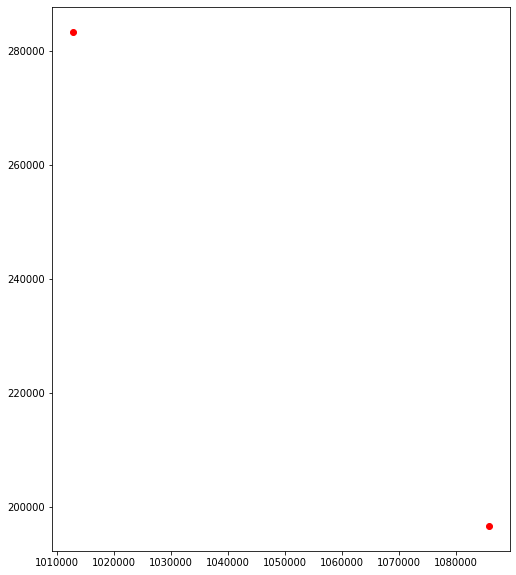
Remove schools that are not in NYC
[23]:
schools = schools[schools['distance_to_node'] == 0]
[24]:
schools.drop('distance_to_node', axis = 1, inplace = True)
Finding the nearest 2 subway entrances¶
Now we want to find the closest 2 subway entrances to each school
Set up the tree for subway location
[25]:
coord_array = np.array(list(zip(subway.geometry.x, subway.geometry.y)) )
subway_tree = cKDTree(coord_array)
[26]:
schools[['distance_to_subway_nodes','subway_ids']] = schools.apply(lambda row: ckdnearest2( row['geometry'], subway_tree, 2),
axis = 1,
result_type = 'expand')
Parse out the subway_node_ids
[27]:
schools['closest_subway_id1'], schools['closest_subway_id2'] = zip(*schools['subway_ids'])
[28]:
schools.head()
[28]:
| ATS_CODE | BORO | BORONUM | LOC_CODE | SCHOOLNAME | SCH_TYPE | MANAGED_BY | GEO_DISTRI | ADMIN_DIST | ADDRESS | ... | PRIN_PH | FAX | GRADES | City | geometry | node_id | distance_to_subway_nodes | subway_ids | closest_subway_id1 | closest_subway_id2 | |
|---|---|---|---|---|---|---|---|---|---|---|---|---|---|---|---|---|---|---|---|---|---|
| 0 | 15K001 | K | 2.0 | K001 | P.S. 001 THE BERGEN | Elementary | 1 | 15 | 15 | 309 47 STREET | ... | 718-567-7661 | 718-567-9771 | PK,0K,01,02,03,04,05,SE | BROOKLYN | POINT (980985.0541713729 175780.758994163) | 109165 | [574.0166423762518, 617.2474703341181] | [1744, 1746] | 1744 | 1746 |
| 1 | 17K002 | K | 2.0 | K002 | M.S. 002 | Junior High-Intermediate-Middle | 1 | 17 | 17 | 655 PARKSIDE AVENUE | ... | 718-462-6992 | 718-284-7717 | 06,07,08,SE | BROOKLYN | POINT (997785.1364296663 178431.910832498) | 109166 | [258.5002370023575, 442.8355620846949] | [1349, 749] | 1349 | 749 |
| 2 | 21K095 | K | 2.0 | K095 | P.S. 095 THE GRAVESEND | K-8 | 1 | 21 | 21 | 345 VAN SICKLEN STREET | ... | 718-449-5050 | 718-449-3047 | PK,0K,01,02,03,04,05,06,07,08,SE | BROOKLYN | POINT (991224.9830063033 156323.3612131244) | 109167 | [431.5770408752747, 492.43651609913985] | [1522, 1591] | 1522 | 1591 |
| 3 | 21K096 | K | 2.0 | K096 | I.S. 096 SETH LOW | Junior High-Intermediate-Middle | 1 | 21 | 21 | 99 AVENUE P | ... | 718-236-1344 | 718-236-2397 | 06,07,08,SE | BROOKLYN | POINT (988439.6813609767 160709.9926236183) | 109168 | [1366.7287949334989, 1549.5096241139383] | [443, 203] | 443 | 203 |
| 4 | 21K097 | K | 2.0 | K097 | P.S. 97 THE HIGHLAWN | Elementary | 1 | 21 | 21 | 1855 STILLWELL AVENUE | ... | 718-372-7393 | 718-372-3842 | PK,0K,01,02,03,04,05,SE | BROOKLYN | POINT (988205.0729096507 158329.5913366843) | 109169 | [1224.1544066200531, 1270.3197366749077] | [190, 189] | 190 | 189 |
5 rows × 23 columns
[29]:
subway.head()
[29]:
| index | line | name | objectid | url | geometry | node_id | |
|---|---|---|---|---|---|---|---|
| 0 | 0 | 2-5 | Birchall Ave & Sagamore St at NW corner | 1734.0 | http://web.mta.info/nyct/service/ | POINT (1020670.668616476 248679.9905504963) | 107248 |
| 1 | 1 | 2-5 | Birchall Ave & Sagamore St at NE corner | 1735.0 | http://web.mta.info/nyct/service/ | POINT (1020710.253511059 248665.112299423) | 107249 |
| 2 | 2 | 2-5 | Morris Park Ave & 180th St at NW corner | 1736.0 | http://web.mta.info/nyct/service/ | POINT (1019251.986414479 245782.8697043241) | 107250 |
| 3 | 3 | 2-5 | Morris Park Ave & 180th St at NW corner | 1737.0 | http://web.mta.info/nyct/service/ | POINT (1019419.817771734 245866.9102186682) | 107251 |
| 4 | 4 | 2-5 | Boston Rd & 178th St at SW corner | 1738.0 | http://web.mta.info/nyct/service/ | POINT (1017557.721758398 245631.8322767556) | 107252 |
Merging in the respective node_ids for the nearest subway locations
[30]:
schools = schools.merge(subway[['index','node_id']],
how = 'left',
left_on = 'closest_subway_id1',
right_on = 'index')
[31]:
schools.drop('index', axis = 1, inplace = True)
schools.rename(columns={"node_id_y": "subway_node_id1"},inplace =True)
[32]:
schools = schools.merge(subway[['index','node_id']],
how = 'left',
left_on = 'closest_subway_id2',
right_on = 'index')
[33]:
schools.drop('index', axis = 1, inplace = True)
schools.rename(columns={"node_id": "subway_node_id2"},inplace =True)
[34]:
schools.rename(columns={"node_id_x": "node_id"},inplace =True)
[35]:
def network_distance(graph, node_gdf, origin_node, target_node, weight_name):
""""
graph is the networkx graph
node_gdf is the geodataframe of nodes. This will allow us to create the LineString.
origin_node is the starting node to begin the network distance
target_node is the end node to end the network distance
weight is the distance measure
We use the shortest_path function from networkx.
Use the nodes on the shortest path and extract the coordinates from the node_gdf
Use the geometry from the route_nodes to create the line string
From the line string we will extract the length
"""
try:
route = nx.shortest_path(G=graph, source=origin_node, target=target_node, weight = weight_name)
route_nodes = node_gdf.loc[route]
route_line = LineString(list(route_nodes.geometry.values))
except:
route_line = LineString()
route_line_dist = int(route_line.length)
return route_line, route_line_dist
Network distance¶
[38]:
t0 = time.time()
schools[['route1_geom', 'route1_dist']] = schools.apply(
lambda row: network_distance(G, node_gdf, row['node_id'], target_node = row['subway_node_id1'],weight_name = 'weight'),
axis = 1,
result_type = 'expand')
t1 = time.time()
time_difference = (((t1-t0)/60)/60)
print("It took {0} hours".format(time_difference))
It took 0.002848712139659458 hours
[39]:
t0 = time.time()
schools[['route2_geom', 'route2_dist']] = schools.apply(
lambda row: network_distance(G, node_gdf, row['node_id'], target_node = row['subway_node_id2'],weight_name = 'weight'),
axis = 1,
result_type = 'expand')
t1 = time.time()
time_difference = (((t1-t0)/60)/60)
print("It took {0} hours".format(time_difference))
It took 0.0029577416181564334 hours
Determine which route is shorter between the two
[40]:
schools.loc[(schools['route1_dist'] <= schools['route2_dist']), 'shortest_network_distance'] = schools['route1_dist']
schools.loc[(schools['route1_dist'] > schools['route2_dist']) , 'shortest_network_distance'] = schools['route2_dist']
[41]:
schools.loc[(schools['route1_dist'] <= schools['route2_dist']), 'shortest_network_geom'] = schools['route1_geom']
schools.loc[(schools['route1_dist'] > schools['route2_dist']), 'shortest_network_geom'] = schools['route2_geom']
[43]:
schools['route1_dist'].isnull().value_counts()
[43]:
False 1707
Name: route1_dist, dtype: int64
[60]:
schools.columns
[60]:
Index(['ATS_CODE', 'BORO', 'BORONUM', 'LOC_CODE', 'SCHOOLNAME', 'SCH_TYPE',
'MANAGED_BY', 'GEO_DISTRI', 'ADMIN_DIST', 'ADDRESS', 'STATE_CODE',
'ZIP', 'PRINCIPAL', 'PRIN_PH', 'FAX', 'GRADES', 'City', 'geometry',
'node_id', 'distance_to_subway_nodes', 'subway_ids',
'closest_subway_id1', 'closest_subway_id2', 'subway_node_id1',
'subway_node_id2', 'route1_geom', 'route1_dist', 'route2_geom',
'route2_dist', 'shortest_network_distance', 'shortest_network_geom'],
dtype='object')
[65]:
schools[['node_id','subway_node_id1','subway_node_id2','route1_geom','route1_dist','route2_geom','route2_dist','shortest_network_distance','shortest_network_geom']].loc[schools['shortest_network_distance'] == 0]
[65]:
| node_id | subway_node_id1 | subway_node_id2 | route1_geom | route1_dist | route2_geom | route2_dist | shortest_network_distance | shortest_network_geom | |
|---|---|---|---|---|---|---|---|---|---|
| 993 | 110157 | 108875 | 107599 | GEOMETRYCOLLECTION EMPTY | 0 | GEOMETRYCOLLECTION EMPTY | 0 | 0.0 | GEOMETRYCOLLECTION EMPTY |
| 1018 | 110182 | 108875 | 107599 | GEOMETRYCOLLECTION EMPTY | 0 | GEOMETRYCOLLECTION EMPTY | 0 | 0.0 | GEOMETRYCOLLECTION EMPTY |
| 1042 | 110206 | 108871 | 107599 | LINESTRING (929431.2955717515 137631.694279956... | 4601 | GEOMETRYCOLLECTION EMPTY | 0 | 0.0 | GEOMETRYCOLLECTION EMPTY |
| 1613 | 110772 | 108750 | 107347 | GEOMETRYCOLLECTION EMPTY | 0 | GEOMETRYCOLLECTION EMPTY | 0 | 0.0 | GEOMETRYCOLLECTION EMPTY |
[61]:
fp = r"../intermediate_data/school_subway_route.shp"
schools = schools.set_geometry('shortest_network_geom')
schools[['node_id','shortest_network_geom']].to_file(fp)
[62]:
fp = r"../intermediate_data/school.shp"
schools = schools.set_geometry('geometry')
schools[['node_id','geometry']].to_file(fp)
[48]:
fp = r"../intermediate_data/subway.shp"
subway = subway.set_geometry('geometry')
subway['geometry'].to_file(fp)
Plot the schools, subway and routes¶
[44]:
fig, ax = plt.subplots(figsize=(15, 15))
schools.plot(ax=ax, color = 'blue', markersize = 9, label = 'school')
subway.plot(ax=ax, color = 'red', markersize = 9, label = 'subway')
schools = schools.set_geometry('shortest_network_geom')
schools.plot(ax=ax, color = 'black', linewidth=1, label = 'school routes')
#Set default back
schools = schools.set_geometry('geometry')
plt.title("Routes from NYC schools to nearest subway entrance")
plt.legend(loc='upper left')
ax.set_axis_off()
plt.show();
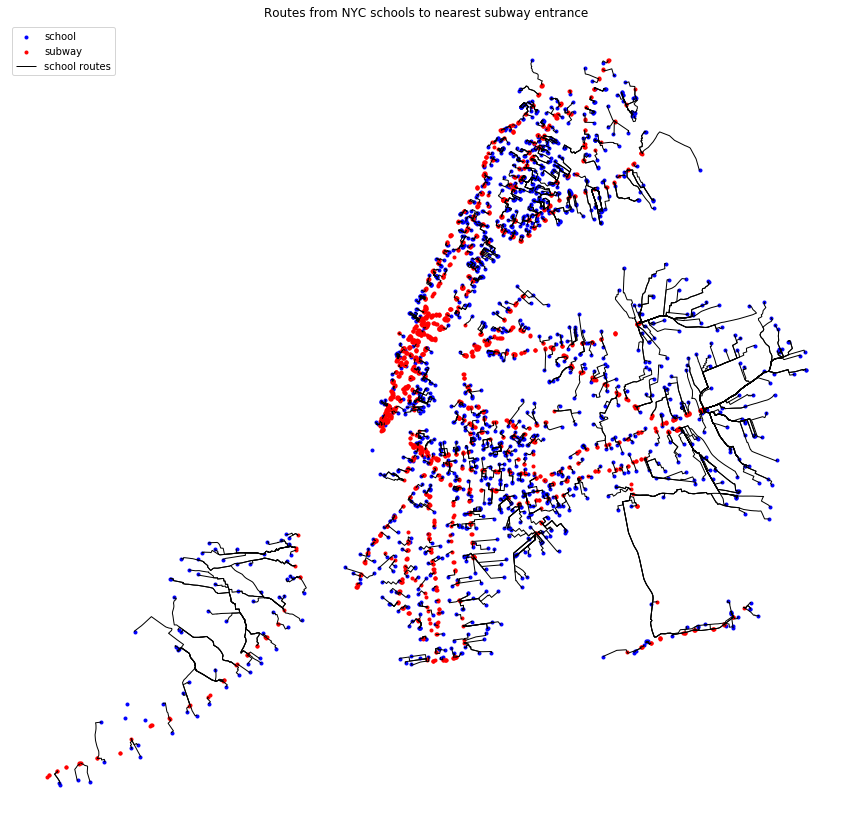
I can see that there are 3 blue dots in Staten Island that should have a route drawn, but the networkx shortest path function did not find a path for these origin nodes. Need to figure out why. The other blue dot south of Manhattan is on Governors island.